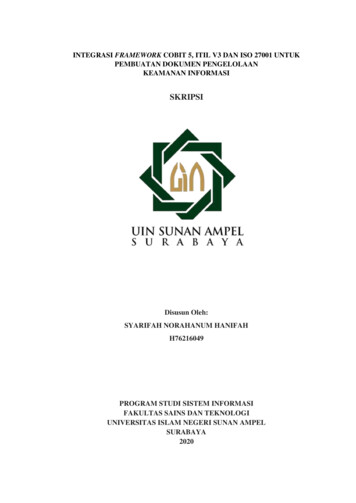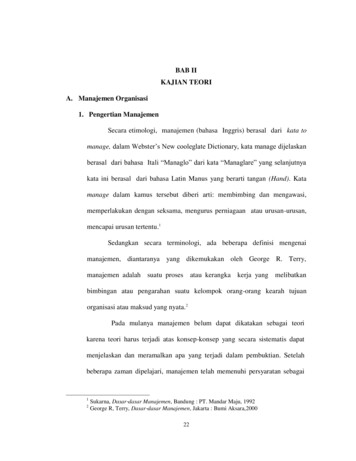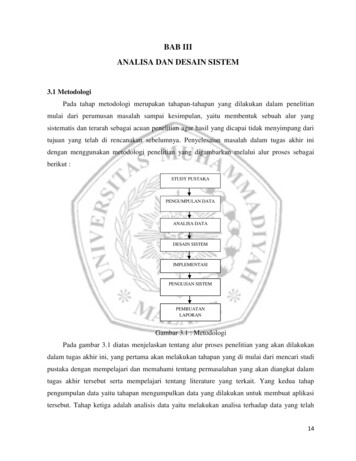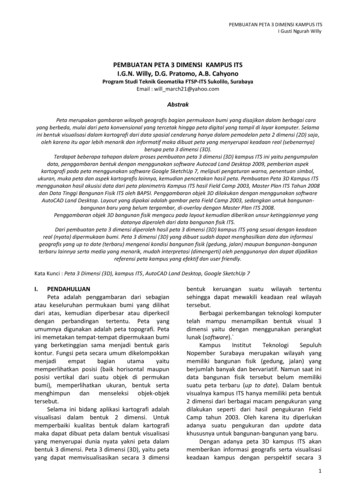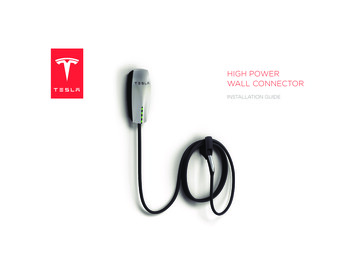
Transcription
From theGround Up!!!Daniel John
IntroductionThis book “doesn’t sound like me.” I keep hearing that when people start readingthe text. “You’re not angry,” “You don’t seem to be ranting,” and “You don’t sound likeyou are going to strangle anybody” are three of the comments that I have heard from theearly reviews.Well, okay. You can fully expect that in the upcoming books, but here, “From theGround Up,” we are going to going to try to encourage people to change the wholemodern paradigm of training and get back to the roots of the sport: pick heavy stuff up.I get dozens of emails a week and talk on the telephone with people who all saythe following basic statement: “I didn’t know I could do it.” What is “it?” Simply, it isfacing down a barbell, picking it up and putting it overhead.That is exactly how I learned to lift. In my very first published article, I wrote:“When my friends and I used to lift the old six foot bar with cement filledweights, we all thought we were pretty strong. Then, Dad would ask us to helphim move a car engine or open a rusted jar of nuts and bolts, or put the ping pongtable up on a rack for storage. Yes, I was the strongest kid in the four-house area,but every Dad had that scary kind of strength that allows one to pick an engineout of a Pontiac station wagon and carry it to the lawn.” (From “The DinosaurFiles”)And, how did me and my friends lift? We had the bar on the ground, picked it upand pushed, pressed or kicked the bar overhead. When somebody learned to clean the barin one motion rather than the five or six that the rest of us used as a “technique” weall adopted the new, better method. Was it perfect? No. Did we get better and better inour sports? Yes. Did we get hurt? Well, of course not we didn’t even know that youcould get hurt “playing.”I want to bring the joy back into lifting weights. I want to see people having funagain in the weight room. I want people to go into their home gym and train withoutfeeling like they can’t because they don’t know the most recent research. For all thesereasons, I titled this book, “From the Ground Up.” Sure, on one hand it deals with takingthe bar from the ground to overhead. Yet, it also reflects my goal of getting across thelessons of training the long-term approach so the athlete (you) can deal with in-seasonand off-season issues, some insights about nutrition and, most important, learning NOTto make the same mistakes over and over and over and over again.In the upper right hand corner of the book, you will see pictures of the Snatch andthe Clean and Jerk. By flipping the pages, you can see the basic lifts in “motion.”Nothing about this book or the series of planned books is too technical. Let’s behonest, the most elaborate thing I have in my gym is a pair of sawhorses. I’m not exactly“cutting edge” yet Throughout this text, you will find great pictures from both Charles Staley andMike Rosenberg. I appreciate the athletes who have allowed me to experiment with themto learn these methods better!From the Ground Up2
Thank you!Thank you to my brothers Rich, Ray, Phil and, especially, Gary who first taught mesports; Coach Bob Lualhauti, Coach Ralph Maughan and Dick Notmeyer who raised mysights, thank you; John Powell, Bill Witt, and Brian Oldfield who made me a studentagain, thank you;Eric Seubert, Paul Northway, Nick Gibson, Nick Aiello, Nick Hristou,Lauren Dorsch, Matt Webber, John Price, John Richardson, Taylor Arrigo-Jones, SteveDiaz, Eric Lindquist and a host of others who wouldn’t let me quit, thank you; MikeRosenberg, Steve Shafley, and others, who have guided my thoughts, thank you. ToCharles Staley for encouraging me to jump in and start writing about these odd passionsthat I enjoy, thank you! Tiffini John, who understands training better than anyone, thankyou; Kelly and Lindsay, who have taught me patience, thank you. Finally, a special thankyou to my Mom and Dad, who have passed over into eternal life for not only the gift oflife, but all those long car drives to remote, lifeless places to cheer me on in my career.To all the others whom I forgot Thank you!!!Daniel JohnCover Shot: Dan is teaching Nick Radonjic the “Modern Method of Pulling. Nick’stoes are on weight plates, he is striving to push his butt to the stick whileconcomitantly trying to stick his chin in the cup of Dan’s hand. His hamstrings arebeginning to shake the perfect sign for a lift.From the Ground Up3
Table of ContentsChapter One: The Basic PremiseWriting about the Olympic Lifts has been done by smarter people in better books, sowhy am I doing this? What equipment do I need? Is it true I only need one piece ofequipment?Chapter Two: The "Rapid Ascent" ProgramIf you are too busy to read the whole book. this chapter is for you.The mistake that most coaches and athletes make is that they too quickly follow the eliteprograms of world or Olympic champions and ignore the essential basics, the buildingblocks, of proper training. With one bar and three simple exercises, you can gatherMOST of the benefits of the most elite, computerized, high tech training programs.Maybe even more.consult the "Summa Liftilogica" for the answers to that conundrum.Chapter Three: From the Floor to Overhead: Olympic LiftingSquat correctly. Clean correctly. Put the bar overhead. Repeat. That is usually my littleformula for teaching people the basics of getting strong. But, people always insist on thefollow up questions: What do I do now? How do I measure up?Chapter Four: Improving on the Basics of Olympic LiftingThis chapter has the two most amazing secrets of not only improving yourOlympic lifting, but it also includes the secrets to athletic success. Two inexpensiveitems which may already be in your garage can teach you to use that thing we callyour “body” more effectively instantly. We will also breeze through an issue that I thinkis overrated, but people love to talk about it. Why? Because most people don’t actuallytrain in a gym, they wave their arms around and talk about training in a gym Chapter Five: Up the Mountain to SuccessYou know, we all talk about the issues raised in this chapter but few go the nextstep up the mountain and implement these ideas. We start with the base, nutrition andwork out way up through the need for “planned recovery,” learning from ourexperiences and, ultimately, using these lessons from our past to successfully chart ourfuture. Yes, it’s simple, but not easy In the last chapter, we discussed Dick Notmeyer's concept of the "Tranquil Mind."Here, we will begin to kick around some of the ideas.some of the practical steps.thatlead to this state. Trust me, having your athletic shoes in your carry on bag will keep youcalmer when the airlines have lost the rest of your luggage!From the Ground Up4
Chapter Six: Long Term Success Making it a HabitDo you open presents on Christmas eve or Christmas morning? What do youeat on Thanksgiving? What color dress would you want your daughter/sister/motherto wear at their wedding? If you can answer those questions without too muchthought you should apply these lessons to athletics!Chapter Seven: The Summa LiftologicaThis is the summary of things that I think are “true,” when it comes to sports andfitness. I put this together years ago and still find it worthy of review every few months Chapter Eight: Questions and AnswersRaise your hand. Go ahead. Now, ask me a question. Get very, very comfortable. Ihave this “thing” about answering questions. Here you can find some insights into inseason training, the body as one piece, training for the busy guy, defining hard work, offseason training, year round training, basic coaching ideas and my take on recruiting.Chapter Nine: The “Boot Camp” NotesIn Las Vegas, I was asked to “frame” long term training success. The DVD of thisworkshop will be available very soon wait for details.Chapter Ten: On Successful Failure and Failing SuccessThe following is from a very special book that I wrote for a very special reason for a veryspecial person. This little entry seemed very fitting for our final chapter.Special Supplement: The Pacifica Barbell Club MaterialsEnjoy! The world’s finest gym was also one of the world’s smallest. Enjoy my memoriesof real training from a master!From the Ground Up5
From the Ground Up6
The BasicPremise.From the Ground Up7
As you crack open this first book of a series of books dedicated to simple trainingmethods, you must be wondering why do we need another book. Hasn't all this been saidalready? Nope.You see, I've been there. I've trained most of my life in garages, or rooms thatwere at one time garages, patios, porches, cement pads, and basements. I've had to lift thebar and avoid hitting the beams in an unfinished room. I've had to be sure to stand on theright pieces of decking so you don't bend the floor and risk breaking through to theground. You see, I've been there.This book is simply dedicated to all those people who have been led to believethis modern lie that the only way to train is in a bright temperature controlled room withTop Forty tunes playing on the perfect stereo system. There are no mirrors in the realworld of athletics and there doesn't have to be any in your gym either. Machines are notthe answer to your fat loss or muscle building questions.I assume only one piece of equipment: a bar. It can be anything, by the way. Ihave trained for national level meets with a six foot bar that didn't rotate and the platesonly went to 25 pounds. That's a lot of 25s on the bar! Sure, I am going to recommendthat maybe you go to a hardware store to upgrade your "gym," but you don't need to dothat, if you don't want to spend money. I understand.The bar will be on the ground. I have full faith in that, by the way, as gravityseems to always make the weights return to the floor. So, "From the Ground Up" is basedon this question: How can we can a total body workout that will cut fat, increase muscleand improve sports performance with just one bar and nothing else? The answer has beenforgotten for a few decades, but I promise you that you will quickly appreciate howsimple.how exhausting.how exhilarating.how fun.how challenging.working out"From the Ground Up" can be for you.We begin with the "Rapid Ascent" Program based directly on the first trainingprogram I ever learned. It still amazes me that this program can still burn fat and buildmuscle as well as any computerized, machine laden program one can find. If you justwant to jump in.jump in there. The next two chapters introduce you to the basics of theOlympic Lifts: the Snatch, where you take the bar from the floor to overhead in onemotion, and the Clean and Jerk, where you will take the bar off the ground and bring it toyour chest (you see.you "clean" the floor of the bar) and then, in one explosive totalbody motion, push the bar overhead. If you get good enough, you can be in the Olympics.The first of these two chapters walks you through the basics of learning the lifts. Even ifyou are a master, take a few minutes to review these tips and ideas. The second of thesechapters introduces the "Three Keys" and we will discuss the two physical issues, LegStrength and Pulling Strength.The next chapter discusses what I consider the core of athletic success.correctlyclimbing the ladder of nutrition, recovery, record keeping and wisdom from experience.From the Ground Up8
Simply by taking the time to think about things a little early will practicallygaurantee success later on. Yet, few do this! This chapter knits together the basicbricks of an athlete or health enthusiast's career, from something as simple as eatingbreakfast every day or keeping a journal, to approaching national or internationalcompetition. Taking care of the details.early.is usually the key to preparing theathletic mindset needed for victory. When proper preparation meets competition, theathlete can relax and smile knowing the work has been done. We call this the "TranquilMind."Following the chapters that deal with the practical side of training, the next twochapters deal with the "thinking" behind my approach to sports and life. The "Summa" isa series of six basic points about.well, everything. Recently, I added the sixth concept,but it might simply be considered the "heart" behind the practical principles. The nextsection, the Question and Answers, deals with a series of seemingly simple issues thatunderscore some of the great issues facing athletes today. People will ask me a verysimple question, yet either I am extremely long winded (probably the right answer!) orthe question simply opens up a whole discussion that we may simply have missed.The last chapter might seem odd, but, in my heart, I think that understanding theroles of "Successful Failure" and "Failing Success" in one's life can make a break aperson.The heart and soul of this book is the belief.my belief.that the athlete, thefitness enthusiast, or the health seeker is capable of training at level of excellenceunmatched by most gyms, spa or training centers all in comfortable surroundings of theirhome gym. Contrary to popular opinion.and an industry fueling this notion .you cantrain at home with a minimal investment of a simple bar. In fact, if you ask around, youmight have a cousin, friend, or neighbor with one rusting in their garage right now. That'show I started and that is the same path that many, many other athletes began their careers.So, climb on board and let's get started.Summary:1. Get a barbell and let’s go!From the Ground Up9
The"RapidAscent"ProgramIf you are too busy to read the whole book. this chapter is for you.The mistake that most coaches and athletes make is that they too quickly followthe elite programs of world or Olympic champions and ignore the essential basics, thebuilding blocks, of proper training. With one bar and three simple exercises, you cangather MOST of the benefits of the most elite, computerized, high tech training programs.Maybe even more.consult the "Summa Liftilogica" for the answers to that conundrum.From the Ground Up10
The Southwood Junior High Weightlifting ProgramEvery so often, I will get an email from a high school coach about teaching agroup of kids to lift weights. The emails often sound like the task to get kids to lift isinsurmountable. Some of the coaches sound like they need a miracle worker to come inand exorcize the student body before beginning the exercise program.I always argue back to these fine men and women that it can be done easily andinexpensively. I can’t claim any credit from the following program, but I am indebted toMr. Dave Freeman, my ninth grade P.E. coach for making us do this program!After eight years at St. Veronica’s School, I transferred to Southwood Junior Highto begin junior high. It was a helluva transition. From Irish Nuns to public school istransition enough, but I was also going to play football. At 118 pounds of ahem puremuscle, it was obvious to everyone I needed to lift weights.It was at this time I was introduced to Southwood’s lifting program. In a portablebuilding, the school had outlaid about 15 of those cement filled weightlifting sets thateveryone from my generation remembers as their first bar.Mr. Freeman spent little time explaining the “rep-set” system of 8-6-4 because ofeverybody, except me, knew what to do. That is part of the brilliance of theprogram you learned it once and then you lifted. Not exactly rocket science but whoneeds rocket science on the football field?The program was very simple. First, groups of four boys were given a bar. Thebars were weighted from very light maybe 25 pounds up to perhaps close to 100pounds. Each cohort of boys would lift one at a time, put the bar down, then the next boywould lift. The four would constantly move from lifter to watcher the bar neverstopped. The three sets (explained in just a moment) would not take very long in fact,sometimes it was hard to catch your breath in time for your next set.The reps were very simple:First set: 8 repetitionsSecond set: 6 repetitionsThird set: 4 repetitionsThe goal was simple: when you got all 18 reps (8 6 4), you added weight. If youstarted with a bar that was too light, the next workout, you would be bumped up to thenext weight and a stronger group. (Of course, actual variations could include making awhole new group with more weight, too or whatever necessary to make the group worktogether).The program involved four lifts:1 Power Clean2 Military Press3 Front SquatEach lift was done in the 8-6-4 format. The bar was cleaned (once) for the set of MilitaryFrom the Ground Up11
Presses and the bar was also cleaned (once) for the Front Squats. So, each workout theathlete cleaned the bar from the ground to the chest 22 times. If, as some people believe,the Power Clean is the "King of the Exercises," that is a lot of reps with the King!To “hurry up” the training as if it was necessary, there were times when Mr.Freeman recommended combining the Power Clean and Military Presses one clean andone press, repeated for a total of eight reps. This was done with a lighter weight. Onecould also do the Front Squats after the clean and presses, too. I have only done thisonce.and it was an amazing cardiovascular workout.Each day, to warm up, we had to “run two laps and an obstacle course.” The twolaps were about 600 meters and the obstacle course had a wall, various upper bodychallenges, and some balance walking. All in all, this was not a bad program.We trained this program three days a week during the summer before footballseason when we could. Unfortunately, as I was unschooled in proper lifting logic, Istarted to focus on the bench press in high school and erred by ignoring the clean, pressand front squat. I was on the right track here, but, as youth often does, I went the wrongway.The "Rapid Ascent" ProgramThree Days a Week in the Weightroom:Power Clean8-6-4 repsMilitary Press8-6-4 repsFront Squat8-6-4 repsIncrease weight when you get all the reps!Other "musts:"Begin each morning with a good breakfast including protein.Try to eat five to nine servings of fruit and vegetables a day.Sleep for more than eight hours a day (Eight hours and one minute is more!)Wear your seatbelt.Don't smoke.Drink water as your major beverage.That's it.that's the "Rapid Ascent Program." As I always note when I explain one of mytraining programs.it looks so easy on paper! Now, go and do it!Summary:No, it's not a perfect program, but it ain't bad either! One bar on the floor withabsolutely nothing else in the way of equipment can help you on the path to athleticsuccess and your goals in body composition. Many people have used this program as a"fat loss" training program and have found it to be excellent because of the speed of theworkout and the lack of stress on the body's resources. When trying to lose fat, it is agood idea not to beat the body up as it often causes the system to cling on to fat evenharder than before.From the Ground Up12
Don't forget the basics of sleeping and eating, too. It makes no sense to begina rigorous training program, then to undermine it with poor nutrition or simpleexhaustion. And, wear your seat belt!After you finish this workout a few times, you might be ready to startconsidering something else.like the Olympic lifts.From the Ground Up13
From theFloor toOverhead:OlympicLiftingSquat right. Clean right. Put the bar overhead. Repeat. That is usually my little formulafor teaching people the basics of getting strong. But, people always insist on the followup questions: What do I do now? How do I measure up?From the Ground Up14
I can remember being told that the Olympic Lifts were dead just a few yearsago. The machines, the "protocols," the safety issues, and the this's and that's had putthe nails in the coffin for those who snatch and clean and jerk. Do a snatch at a spa andthe first question from the spandex bunch is "what does that build?" Then, the ownerkicks you out for scaring the grandmas in the step aerobic class.But recently, there has been a surge of interest in the sport and the lifts. Football coaches,breaking from the decades of "following the follower" and non-productive training, haveembraced the snatch and clean as basic training for their athletes. Of course, track andfield athletes, at least at the elite level, seem to have continued pulling and pushing in theincreasingly darker ends of gyms and spas. The internet, for all its problems, seems tohave been part of this phenomenon that has found a resurgence in the popularity of the Olifts.Starting the true neophyte off in the O lifts is a matter of debate, but I would follow theBulgarian method. Simply, the Bulgarians begin by teaching a perfect deep back squat.This means that the athlete has a high bar placement on the upper traps, the chest is heldup, and the lower back tucked in. The athlete sits straight down "between" the legs andcontinues down until "the ass is on the grass."What does "between the legs" mean? One of the true keysto squatting and the O lifts is this simple concept. I teach itthis way: have the athlete stand arms length from a doorknob. Grab the handle with both hands and get your chest"up." Up? I have the athlete imagine being on a Californiabeach when a swimsuit model walks by.Immediately, the athlete puffs up the chest which tightens the lower back and locks thewhole upper body. The lats naturally spread a bit and the shoulders come back "a little."Continuing with the arms in the "hammer throwing" position, with the Muscle Beachchest, lean back away from the door.Now, lower yourself down. How? Well, I teach young lifters to think that their feet werestuck to the ceiling and they would have to pull their butt to the ceiling. Sure, an oddimage, but it works. What people discover at this moment is a basic physiological fact:the legs are NOT stuck like stilts under the torso. Rather, the torso is slung between thelegs. (Below: The “Front Squat,” with the bar resting on the shoulders)From the Ground Up15
As you go down, leaning back with arms straight, you will discover one of the truekeys of lifting: you squat "between your legs." You do not fold and unfold like anaccordion, you sink between your legs. Don't just sit and read this: do it! To develop theability to squat snatch or squat clean hinges on this principle!Foot stance, hand grip, and most questions are not as relevant as the key point of sittingbetween your legs. I must admit, I usually just have someone jump two or three times.Note where they land on jumps two and three. Have them look at their heel to toealignment. "That" is the stance. A touch wider, a touch narrower, it takes a few tries, but Ithink it is fairly natural.(Below: The “Overhead Squat” with the bar locked out over the head.)The best way to fix squat problems is to.squat. I think that alternating the three greatvariations (back, front and overhead) as well as occasionally adding the "old" lifts likeJefferson or straddle the bar squats or Hip Belt Squats (a special belt with chains isattached to the weight and you simply squat up and down) is the best way to fixproblems. Overhead squats teach the arch of the lower back better than any drill, as wellas providing a superior back isometric. Front Squats certainly push the stress more to thequads as well as demanding increased flexibility. Back squats clearly help the other twovariations by pushing the load higher. So,.if your struggling on one: focus on the others!To Summarize:1 Sit "between your legs"2 Minimize shin movement3 Keep a big chest and big arch in your back4 Everytime you get hurt, not sore, squatting.have someone watch your shins; theyshouldn’t be coming forward very much at all.5 Done correctly, squats may be the single exercise you need to do for success insports. Done correctlyNext, the Bulgarians teach the clean, arguing it is simpler than the snatch. This parallelsmy learning experience, too. Growing up with the Ted William's Sears cement filledbarbell, we all cleaned and pressed as young lifters.From the Ground Up16
1. That Muscle Beach chest position, with the lower back locked in and lats puffed etal, must be maintained throughout the lifts.2. As you address the bar, the "get set" position, think of your arms as ropes orcables. Keep them long and loose.3. I like to start with my hands on the bar and my legs "sorta" straight, then squeeze myhips down to the starting position. It helps for me to flex my lats and literally pull my buttdown BEFORE I begin the pull.4. The best advice I know to get the bar going up is to "Push the Floor Away." You needto hold the hips and shoulders in the same angle to the floor for “as long as you can."Physics and physiology will help you finish the lift correctly. Former champ, Russ Knippargues that all you ever do in pulling, throughout the whole clean or snatch is to focus onpushing the floor down. Think of this first part, the "first pull," as a leg press on amachine. An even better image is to think of pushing your heels all the way through theearth.5. For new lifters, I stress a drill that sounds crazy, but works well. I teach new lifters totake the bar from the floor to about two inches above the knee as SLOWLY as possible,one inch a second. Why? It teaches the core truth of lifting (and throwing events): properacceleration. When the bar gets to that spot two inches above the knee: jump! That's it.Snatch or clean, you have just learned the key principles.After mastering the clean, while continuing doing the squats, it is time to put the baroverhead. In the ideal world, the athlete would have a set of tall boxes two feet lowerthan shoulder height. The bar would be placed on these high boxes, the athlete wouldgrab the bar, place it on the chest and stand tall. Standard racks work well very well, infact but there is nothing that builds confidence more than a safe place to dump a lift.Pad the floors, if you must, and consider buying bumper plates those rubber plates thatcushion the sound and protect the gym.Over a period of weeks, the athlete would learn the truemilitary press, the power press (the lifter starts the presswith a leg push), the power jerk (after starting the lift withthe legs, the athlete "catches" the bar with bent legs whenthe momentum stops), the split jerk (the athlete dips thebar by bending the knees, drives it over head, thencatches the bar by slapping the feet fore and aft) and thebehind the neck variations of the same lifts.Finally, the athlete would slide the hands out to the snatchgrip, push the floor away, jump and "snatch" the baroverhead. Throughout this basic training, the athletewould be exposed to variations of the squat (basically theFrom the Ground Up17
front and overhead squat) and lots of flexibility work, as well as an orientation to thehistory of the sport and the rules of the sport.If you have no interest at all in these lifts shocking!.here is a simple addition toadd to your workout:Pressouts. I learned this trick from Pacifica Barbell Club coach Dick Notmeyer.Simply, at the end of any overhead lift, including presses, jerks, or push jerks or presses,finish the set with “pressouts.” As you stand tall, with arms locked out overhead, bendyour elbows so the bar moves no more than three inches. Continue to do this up to eighttimes. Now, put the bar down. As simple as this seems, this exercise builds the wholesupport system. Soon, you may notice the serratus muscles, the “fingers” on the rib cage,becoming a lot more noticeable. As your body tightens to compensate during thepressouts, you are building support strength.This idea may be used any time. Try sneaking the pressouts into a workout, by theway, it also works in bench presses, but have a good spotter. You’ll see the difference inyour ability to support the big weights.12345Now, let’s go from floor to overhead with the bar. Why?Great for cardiovascular conditioning try it and see!True measure of strengthImpress your friends!Get functional strengthLift in REAL meets!I’m telling you, the best single investment you can make is a piece of PVC pipe oran old broomstick. Use the stick to perfect your positions. In addition, the athlete wouldbe exposed to lots of repetitions with broomsticks while learning the basic terms oftraining and method. You will be amazed at how much sweat this stick can produce!Dave Turner's Hercules Barbell Club beginners use a simple program for learningand developing the rudiments of strength. Three days a week, the team members gothrough a ten minute warm up of shoulder "dislocates" with broomsticks, overhead squatswith broomsticks, followed by front squats, then a "cardio-like" few minutes of snatchesand clean and jerks with the broomsticks. Dave reinforces the terms used in lifting: "Getset," "Push the floor," "Jump," "Dip," and "Down."Then, Dave’s team does the following simple workout three days a week:Warm Ups (with the Broomstick)Snatch: 8 Sets of Doubles (A “Double” is two perfect repetitions)Clean and Jerk: 8 Sets of Singles (A “Single” is a perfect repetition)Front Squat: 5 Sets of 5 RepetitionsPress: 5 Sets of 3 RepetitionsFrom the Ground Up18
If your form is perfect, you add weight the next workout, if not, you stay atthis weight. I know, I know, it looks easy on paper. Try it.then, tell me it is easy.Dave is teaching his lifters how to lift during the warm ups! I stole this idea for mydiscus throwers and our throwers warm up with the basic movements over and overand over again of “Stretch-1-2-3.” They hear the terms, do the movements andwarm up their bodies and their techniques at the same time.Next, Dave’s workout is always the same with one variation. Theathletes all do the same program but they start at different lifts. A typicalvariation:Clean and Jerk: 8 Sets of SinglesFront Squat: 5 Sets of 5Press : 5 Sets of 3Snatch : 8 Sets of DoublesSo, one day, an athlete might start at
Chapter Four: Improving on the Basics of Olympic Lifting This chapter has the two most amazing secrets of not only improving your Olympic lifting, but it also includes the secrets to athletic success. Two inexpensive items which may already be in your garage can teach you to use t



